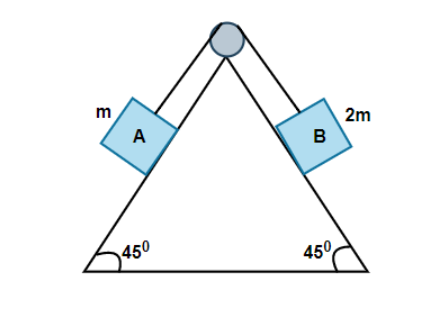
The velocity vector $v$ and displacement vector $x$of a particle executing SHM are related as \[V\dfrac{{dv}}{{dx}} = - {w^2}x\] with the initial condition \[v = {v_0}\]at \[x = 0\] the velocity \[{v_s}\] when displacement is$x$, is
(A) \[v = \sqrt {v{}_0^2 + {w^2}{x^2}} \]
(B) \[v = \sqrt {v{}_0^2 - {w^2}{x^2}} \]
(c) \[v = \sqrt {v{}_0^3 + {w^3} + {x^3}} \]
(D) \[v = {v_0} - {({w^3}{x^3}{e^x}^{^3})^{\dfrac{1}{3}}}\]

Answer
203.4k+ views
Hint In mechanics and physics, simple harmonic motion is a special type of periodic motion where the restoring force on the moving object is directly proportional to the object's displacement magnitude and acts towards the object's equilibrium position. It is vibratory motion in a system in which the restoring force is proportional to the displacement from equilibrium
Step by step solution
As it is Simple harmonic motion so the equation of motion will be
\[F = - kx\]
Or the equation can be written as
\[\dfrac{{vdv}}{{dx}} = - {\omega ^2}x\]
Now integrating the expression with boundary condition,
\[\int\limits_{{v_0}}^v {vdv} = - {\omega ^2}\int\limits_0^x {xdx} \]
After integrating the above equation we get
$\left[ {\dfrac{{{v^2}}}{2}} \right]_{{v_0}}^v = - {\omega ^2}\left[ {\dfrac{{{x^2}}}{2}} \right]_0^x$
Now we have to apply the limit in the above equation so we get
$\left[ {\dfrac{{{v^2}}}{2} - \dfrac{{v_0^2}}{2}} \right] = - {\omega ^2}\left[ {\dfrac{{{x^2}}}{2}} \right]$
Now we have to do further calculation then we get
$\dfrac{1}{2}\left[ {{v^2} - v_0^2} \right] = \dfrac{{ - {\omega ^2}{x^2}}}{2}$
Now after simplifying the above equation we get
$v = \sqrt {v{}_0^2 - {\omega ^2}{x^2}} $
Hence the correct answer is option is (B)
Note
A speed vector speaks to the pace of progress of the situation of an object.The greatness of a speed vector gives the speed of an article while the vector course gives its direction.Velocity vectors can be added or deducted by the standards of vector addition.In math and mechanics, a relocation is a vector whose length is the most limited good ways from the underlying to the last situation of a point P going through movement. It quantifies both the distance and direction of the net or total motion along a straight line from the initial position to the final position of the point trajectory. A displacement may be identified with the translation that maps the initial position to the final position.
Step by step solution
As it is Simple harmonic motion so the equation of motion will be
\[F = - kx\]
Or the equation can be written as
\[\dfrac{{vdv}}{{dx}} = - {\omega ^2}x\]
Now integrating the expression with boundary condition,
\[\int\limits_{{v_0}}^v {vdv} = - {\omega ^2}\int\limits_0^x {xdx} \]
After integrating the above equation we get
$\left[ {\dfrac{{{v^2}}}{2}} \right]_{{v_0}}^v = - {\omega ^2}\left[ {\dfrac{{{x^2}}}{2}} \right]_0^x$
Now we have to apply the limit in the above equation so we get
$\left[ {\dfrac{{{v^2}}}{2} - \dfrac{{v_0^2}}{2}} \right] = - {\omega ^2}\left[ {\dfrac{{{x^2}}}{2}} \right]$
Now we have to do further calculation then we get
$\dfrac{1}{2}\left[ {{v^2} - v_0^2} \right] = \dfrac{{ - {\omega ^2}{x^2}}}{2}$
Now after simplifying the above equation we get
$v = \sqrt {v{}_0^2 - {\omega ^2}{x^2}} $
Hence the correct answer is option is (B)
Note
A speed vector speaks to the pace of progress of the situation of an object.The greatness of a speed vector gives the speed of an article while the vector course gives its direction.Velocity vectors can be added or deducted by the standards of vector addition.In math and mechanics, a relocation is a vector whose length is the most limited good ways from the underlying to the last situation of a point P going through movement. It quantifies both the distance and direction of the net or total motion along a straight line from the initial position to the final position of the point trajectory. A displacement may be identified with the translation that maps the initial position to the final position.
Recently Updated Pages
JEE Main 2026 Session 1 Form Correction Window – Edit Application Details Online

JEE Main Login 2026 - Step-by-Step Explanation

Find the frictional force between the two blocks in class 11 physics JEE_MAIN

Derive an expression for maximum speed of a car on class 11 physics JEE_Main

JEE Main Eligibility Criteria 2026: Age Limit, Qualifications & Attempts

JEE Main 2025 Session 2 City Intimation Slip Released - Download Link

Trending doubts
JEE Main 2025 Session 2: Application Form (Out), Exam Dates (Released), Eligibility, & More

Atomic Structure: Definition, Models, and Examples

Angle of Deviation in a Prism – Formula, Diagram & Applications

Hybridisation in Chemistry – Concept, Types & Applications

Collision: Meaning, Types & Examples in Physics

Equation of Trajectory in Projectile Motion: Derivation & Proof

Other Pages
Units And Measurements Class 11 Physics Chapter 1 CBSE Notes - 2025-26

NCERT Solutions for Class 11 Physics Chapter 7 Gravitation 2025-26

JEE Advanced Marks vs Ranks 2025: Understanding Category-wise Qualifying Marks and Previous Year Cut-offs

JEE Advanced 2025: Dates, Registration, Syllabus, Eligibility Criteria and More

NCERT Solutions for Class 11 Physics Chapter 5 Work Energy And Power 2025-26

NCERT Solutions For Class 11 Physics Chapter 2 Motion In A Straight Line - 2025-26




